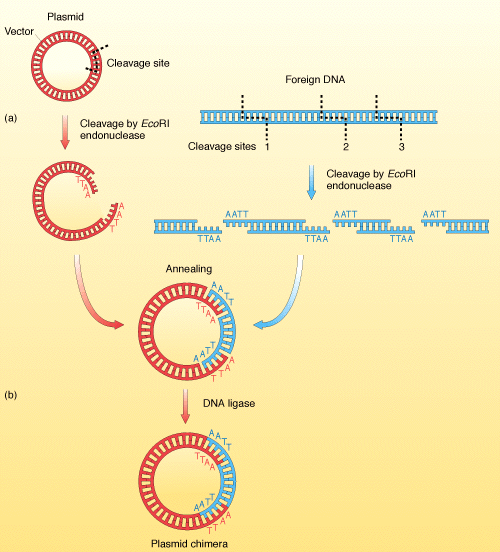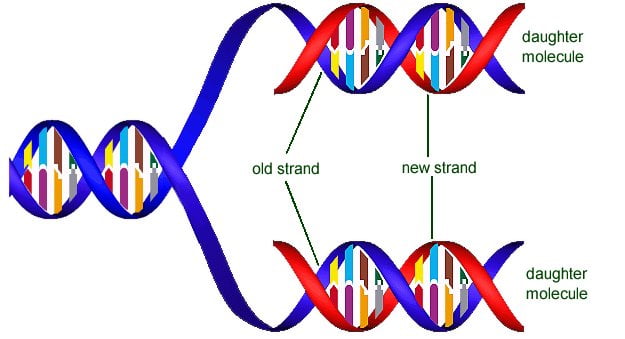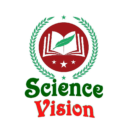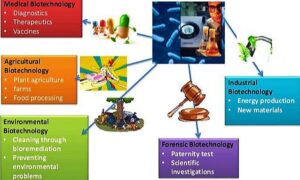Biotechnology :-
Biotechnology is recent branch of biology .
Biotechnology deals with the techniques of using live organisms or enzymes from organisms to produce products and processes useful to humans .
- Biotechnology is control use of microbes for the benefit of human beings .
- In Biotechnology principles of Biochemistry , Molecular biology ,Genetics and Microbiology are mostly used .
- National Biotechnology Board of India – under the department of Science and Technology Government of India . its co-ordinate researches on Biotechnology carried in India and Abroad . So that new methods developed can be applied in industries associated with biotechnological products .
Principles of Biotechnology :-
The two techniques are used for the development of modern Biotechnology .
( 1 ) Genetic Engineering :-
This techniques are used for the development of Biotechnology
The techniques to alter the chemistry of genetic material ( DNA and RNA ) to introduce these into host organisms and thus change the phenotype of the host organism .
- The techniques of Genetic Engineering include creation of Recombinant DNA , Gene cloning and Gene transfer .
( 2 ) Chemical Engineering :-
In Chemical Engineering process to enable growth of only the desired microbe / Eukaryotic cell in large quantities for the manufacture of biotechnology products like – vaccines , antibiotics , enzymes etc .
Chemical Engineering is an important technique for modern Biotechnology .
Tools for Genetic Engineering or Recombinant DNA Technology :-
- Restriction Enzymes
- Polymerase Enzymes
- Ligase Enzymes
- Cloning Vectors
- Host Organism
Restriction Enzymes :-
In the year 1963 , the two enzymes responsible for restricting the growth of bacteriophage in Escherichia coli were isolated . One of these added methyl groups to DNA , while the other cut DNA . The later enzyme was called restriction endonuclease .
- The first restriction endonuclease Hind – II. This enzyme always cut DNA molecules at a particular point by recognising a specific sequence of 6 base pairs .
- Today we know more than 900 restriction enzymes that have been isolated from over 230 strains of bacteria each of which recognise different recognition sequence .
- Some Endonuclease Enzymes ,Sources ,Recognition and Cleaves :-
Enzymes. Source of Enzymes. Recognition.
EcoRI E . coli. GAATTC
Bam HI Bacillus amyloliq.. GGATCC
Hind III. Haemophilus influe.. AAGCTT
- Restriction enzymes belongs to a large class of enzymes called nucleases , these are of two kinds –
- Exonucleases :- they remove nucleotides from the end of the DNA .
- Endonucleases :- they make cuts at specific position within the DNA .
- Each restriction endonuclease functions by inspecting the length of a DNA sequence . Once it finds its specific recognition sequence , it will bind to the DNA and cut each of the two strands of the double helix at specific points in their sugar phosphate backbones .
- Each restriction endonuclease recover any recognises a specific palindromic nucleotides sequences in the DNA .
Example – EcoRI enzyme cut the nucleotide sequences GAATTC of plasmid between G and A , due to which plasmid DNA gets open and both ends becomes free .

Plasmid :- A genetic structure in a cell that can replicate independently of the chromosomes , typically a small circular DNA strand in the cytoplasm of bacteria or protozoan .
Polindromes :-
There are groups of letters that form the same words when read both forward and backward .
Example – MALAYALAM .
- The Palindrome in DNA is a sequence of base pairs that reads same on the two strands when orientation of reading is kept the same .
Example – The following sequences reads the same on the two strands in 5′ to 3′ direction , this is called true if read in the 3′ to 5′ direction .
5′ → GAATTC – 3′
3′ → CTTAAG – 5′
Polymerase Enzymes :-
A polymerase is an enzyme that synthesizes long Chains of polymers or nucleic acids . DNA polymerase and RNA polymerase are used to assemble DNA and RNA molecules respectively by copying a DNA template strand using base pairing interactions or RNA by half ladder replication I . e . DNA polymerase is an enzyme that synthesizes DNA molecules from Deoxyribonucleotides ,
The building blocks of DNA . These enzymes are essential for DNA replication and usually work in pairs to create two identical DNA strands from a single original DNA molecule .
Ligase Enzymes :-
A ligase is an enzyme that can catalize joining of two large molecules by forming a new chemical bond , usually with accompanying hydrolysis of small chemical group on one of the large molecules .
- When cut by the same restriction enzyme , the resultant DNA fragments have the same kind of sticky ends and these can be joined together ( end to end ) using DNA ligases .
Cloning Vectors :-
A cloning vector is a small piece of DNA that can be stably maintained in an organism and into which a foreign DNA fragment can be inserted for cloning purposes .
- The cloning vector may be DNA taken from a virus , the cell of of higher organism or it may be the plasmid of a bacteria .
- The following are the features that are required to facilitate cloning into a factor .
1 . Origin of replication :-
This is a sequence from where replication starts and any piece of DNA when linked to this sequence can be made to replicate within the host cell . This sequence is also responsible for controlling the copy number of the linked DNA .

2 . Selectable marker :-
In addition to origin of replication , the Vector requires a selectable marker which help in identifying and eliminating non transformants and selectively permitting the growth of the transformants .
Transformant is a producer through which a piece of DNA is introduced in a host bacterium .
3 . Cloning sites :-
In order to link the alien DNA the vector needs to have very few , preferably single recognition sites for the commonly used restriction enzyme .
- Presence of more than one recognition sites within the Vector will generate several fragments , which will complicate the gene cloning .

4 . Vectors for Cloning genes in Plants and animals :-
In nature the transferring of genes into plants and animals through bacteria and virus .
example – Agrobacterium tumifaciens , a pathogen of several dicot plants is able to deliver a piece of DNA known as T -DNA to transform normal plant cells into tumor and direct these tumor cells produce the chemicals required by the pathogen . Similarly ,
Retroviruses in animals have the ability to transform normal cells into cancerous cells .
Host Organism :-
The organisms in which introduce the genetic material ( DNA and RNA ) to change their phenotype are called host organisms . Host organisms may be animals , plants and microbes .
Process of Recombinant DNA technology :-
Recombinant DNA technology is related to the biotechnology .
Recombinant DNA technology involves following steps in specific sequence –
Isolation of DNA . → Fragmentation of DNA by restriction enzyme. → Isolation of desired DNA fragment . → Ligation of DNA fragment into Vector by ligase enzyme . → Transfer of Recombinant DNA into the host cells . → Culture of host cells in the medium . → Extraction of desired product .
Isolation of DNA :-
The cell is first treated with suitable enzymes to break the cell membrane or cell wall . Now , RNA is removed by treatment with ribonuclease protein is removed by treatment with protease , other molecules are removed by suitable treatments after that addition of chilled Ethanol facilitates the precipitation of purified DNA .
Fragmentation or cutting of DNA :-
Purified DNA molecules are incubated with restriction enzyme . Optimal conditions are maintained for a particular enzyme .
- The progress of a restriction enzyme digestion is checked with the help of Agarose gel electrophoresis . As DNA is negatively charged , it moves towards the positive electrode ( anode ) . this process is repeated with the Vector DNA . Agarose is a natural polymer obtain from Sea weeds .
Separation and Isolation of DNA fragments :-
The cutting of DNA by restriction endonuclease results in the fragments of DNA .These fragments can be separated by a technique known as Gel electrophoresis .
Ligation of DNA fragment into Vector :-
The cut portion of the source DNA and the cut Vector are mixed and ligase is added . this results in the preparation of Recombinant DNA .

Polymerase chain reaction ( PCR ) :-
PCR stands for polymerase chain reaction . In this reaction , multiple copies of the gene or DNA of interest is synthesised in vitro using two sets of primers ( small chemically synthesised Oligonucleotides that are complementary to the regions of DNA ) and the enzyme DNA polymerase . The enzyme extends the primers using the nucleotides provided in the region and the genomic DNA as template .
- If the process of replication of DNA is repeated many times , the segment of DNA can be amplified to approximately billion times . I . e . 1 million copies are made .
- PCR is an important reaction used in biotechnology .
Transfer of Recombinant DNA into the host cell / Organism :-
A ligated DNA can be introduced into recipient cells by many methods .
Recipient cells after making them competent to receive , take up DNA present in its surrounding . So , if a Recombinant DNA bearing gene for resistance to an antibiotic ( example – Ampicillin ) is transferred into E . coli cells .
The host cells become transformed into Ampicillin resist cells .
If we spread the Transformed cells on Agar plates containing Ampicillin , only transforments will grow , untransformed recipient cells will die .
Genetic Engineering / Recombinant DNA technology – in Biotechnology use in synthesis of useful products – 1 . Insulin ( Humulin ) 2 . Human growth hormone (GH ) 3 . Interferon .
- GH hormone secreted by anterior pituitary gland . Its deficiency cause Dwarfism . supply of .
- GH ( Growth hormone ) can be synthesised through Recombinant DNA technology DNA where DNA / Genes needed for the synthesise of GH . First synthesised and then integrated with bacterial plasmid to produce required amount of hormone I . e . GH .
- Interferon :- It is an antiviral Protein I . e .checks viral growth synthesised by viral infected host cell . Interferon is synthesised by Genetic Engineering and effective against Influenza virus , Hepatitis virus etc .


